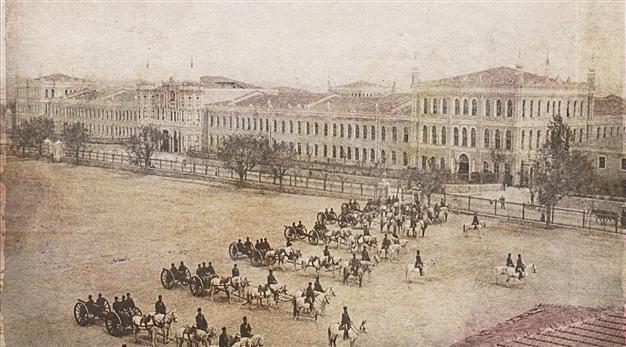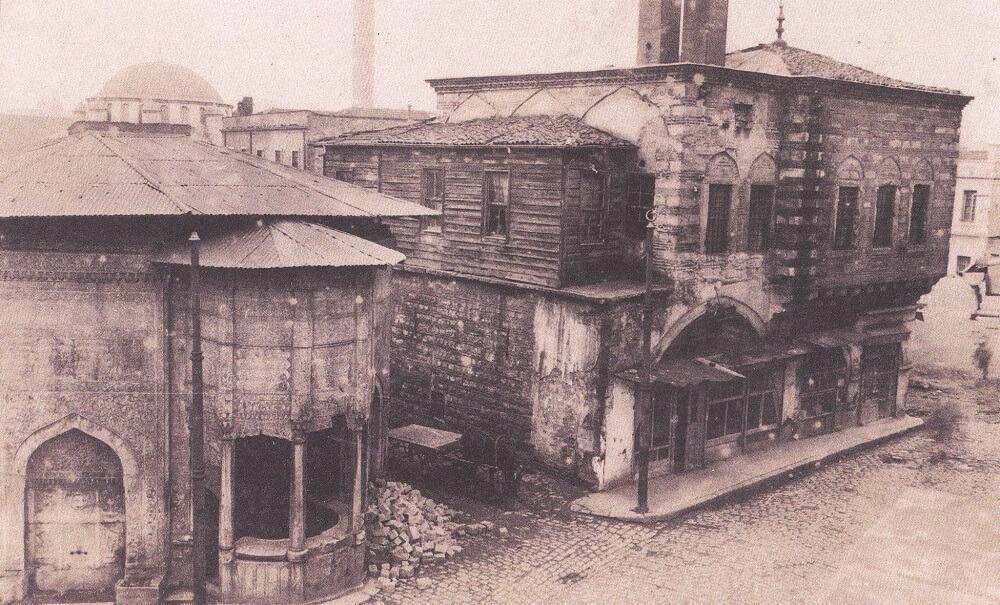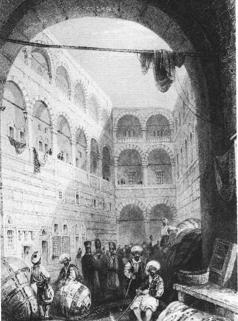Istanbul’s disappearing past
NIKI GAMM

Taksim Topcu Kışlası
“Accessing and discussing the underground world beneath Istanbul is truly an ambitious enterprise. Surprisingly few archaeological excavations have taken place for various reasons and most of the serious work conducted by scientists devoted to the issue of Istanbul’s subterranean feature has been left incomplete … Consequently we do not really have a good account of what is hidden in the subterranean world of the city … This means, therefore, it is inevitable that researchers will lose these traces of history and the hope they have of finding valuable information.”While Ersin Kalkan, the author of the above passage from his book “The World Beneath Istanbul,” is basically describing Roman and Byzantine remains, the same fate awaits Ottoman remains. Fatih Güldal recently produced a book - “Istanbul’un 100 Kaybolan Eseri” (Istanbul’s 100 Lost Works), which is part of the “Istanbul’un Yüzleri Serisi” (The Faces of Istanbul Series) published by Kültür A.Ş. - focusing on the Ottoman period. In this second edition, Güldal covers mescids and mosques, tekkes (dervish lodges), schools, mansions, palaces, hamams and fountains with short descriptions and photos.
According to Güldal in his introduction to the first edition (the second edition is now out), Fatih Sultan Mehmet II followed up on his conquest of Istanbul by constructing buildings such as his palaces and university and by repurposing others - like converting churches to mosques. His successors, members of the imperial family, high government officials and the wealthy followed suit. But Istanbul was subjected to fires and earthquakes that devastated whole swathes of the historic peninsula. Some of the buildings were restored, some were not. Several sultans decreed that wood shouldn’t be used, but obviously it was still employed in spite of the prohibitions. And while brick and mortar were used, these buildings were subject to earthquake damage: “A large part of these beautiful works that the Ottomans created couldn’t be saved from destruction.”
This situation changed in the 19th century with the exposure of the Ottoman Empire to Westernizing, modernizing influences. Efforts to incorporate these influences led to the emulation, among other things, of the fabric of western cities by changing the traditional fabric of Ottoman Istanbul.
Modernizing the city meant tearing out the old. In the middle of the 19th century, Istanbul attracted the attention of western European city planners and architects, some with ideas of fusing Ottoman/Oriental styles with Western trends. The idea of preserving monuments for future generations was not considered. Wide boulevards, spacious parks for promenading and Western-like palaces and mansions were planned to take the place of “old” buildings and monuments, in place of what we today would consider invaluable and irreplaceable.
Güldal describes his work as intended to cherish its purpose of remembering buildings that have been obliterated or allowed to fall into ruin. About half of the entries he gives in his book are mosques that have been completely destroyed, while others are ruins on empty lots. He notes that the madrasas (schools) have been the luckiest, as it has been easy to restore them as schools or repurpose them as culture and art/craft centers.
The following are some examples from “Istanbul’s 100 Lost Works”:
 Çivilimanı Mescidi (İzari Mehmed Efendi): The Çivilimani (Nail Harbor) Mescid was located in Tophane near the Nusretiye Mosque and its first benefactor was Mahmud Çavus. While the place began as an open air prayer center on the shore, it was eventually roofed over and turned into a mescid. After a fire, it was restored by İzari Mehmed Efendi with a dome and minber in the middle of the 18th century. It had an outstanding marble block that showed where Mehmed Efendi was buried, but the whole thing was torn down in 1957 during municipal improvement works. Today there are warehouses where it stood.
Çivilimanı Mescidi (İzari Mehmed Efendi): The Çivilimani (Nail Harbor) Mescid was located in Tophane near the Nusretiye Mosque and its first benefactor was Mahmud Çavus. While the place began as an open air prayer center on the shore, it was eventually roofed over and turned into a mescid. After a fire, it was restored by İzari Mehmed Efendi with a dome and minber in the middle of the 18th century. It had an outstanding marble block that showed where Mehmed Efendi was buried, but the whole thing was torn down in 1957 during municipal improvement works. Today there are warehouses where it stood.Saliha Sultan Sıbyan Mektebi: “Sıbyan mektepleri,” or primary schools, were one of the most important parts of the Ottoman educational system. Wherever one found a mosque, mescid or a soup kitchen, there would most likely be a primary school. One of these schools was built by Saliha Sultan, the wife of Sultan Mustafa II and mother of Sultan Mahmud I, in the Azapkapı area by the Atatürk Bridge. The art historian Semavi Eyice described the school as having a beautiful plaque indicating the date of its building, 1733/34. It had a square plan of brick and stone with three glass windows to illuminate the large salon. The school passed through several hands before being torn down in 1957 because of the need to make improvements to the bridge.

Ali Paşa Konağı: Ali Paşa who was born in 1815 served as grand vizier under Sultans Abdülmecid and Abdülaziz. His konak or mansion, located in the Bayezid area, was among the largest and most important mansions of the late Ottoman period. There had been another building on the site but, when the pasha was out of the country, it burned down and he lost all his possessions inside. Sultan Abdülaziz in 1875 agreed to pay all the expenses to build a new mansion, the architects of which may have been the brothers Agop and Sarkis Balyan. After Ali Paşa died in 1871, the state appropriated the mansion, paying very little for it. Abdülmecid’s daughter resided there for a time and later two daughters of Abdülaziz. It was converted to a school and several quite prominent people were educated there. Later it became army headquarters before burning down in 1911. Eventually it became a car park.
 Elçi Han: The Elçi Han, or Ambassador’s Inn, is known to have been built in 1510-11 as part of the Atik Ali Paşa Mosque complex. It is even mentioned in the 17th century travel account of Evliya Çelebi. It was built at the order Atik Ali Paşa to replace his own mansion that had been destroyed in 1509 during an earthquake. It acquired the name Ambassador’s Inn because many of the foreign ambassadors who came to Istanbul stayed there from the 16th century onwards. According to what the ambassadors related, it was a two-story square large enough to house 400 horses. The han began to slowly lose its former function when ambassadors started preferring to stay in Galata. By the 19th century, it had become a ruin and finally was torn down in 1965. Today a culture/arts center, the FKM, sits where it used to be in Çemberlitaş.
Elçi Han: The Elçi Han, or Ambassador’s Inn, is known to have been built in 1510-11 as part of the Atik Ali Paşa Mosque complex. It is even mentioned in the 17th century travel account of Evliya Çelebi. It was built at the order Atik Ali Paşa to replace his own mansion that had been destroyed in 1509 during an earthquake. It acquired the name Ambassador’s Inn because many of the foreign ambassadors who came to Istanbul stayed there from the 16th century onwards. According to what the ambassadors related, it was a two-story square large enough to house 400 horses. The han began to slowly lose its former function when ambassadors started preferring to stay in Galata. By the 19th century, it had become a ruin and finally was torn down in 1965. Today a culture/arts center, the FKM, sits where it used to be in Çemberlitaş.Taksim Topcu Kışlası: The area at Taksim Square used to consist of cemeteries and a military parade ground. But the cemeteries were moved to Şişli and an extensive military barracks for the artillery corps was built in the 19th century where they had been – possibly between 1803 and 1806. It was damaged during a rebellion in 1807 and repaired in 1812 by Sultan Mahmud II as part of his attempts to reform and modernize his army. During the reign of Sultan Abdülhamid II a second floor was built on it and in its center there was a rectangular courtyard. It was damaged in another rebellion and not repaired. During the Allied occupation following World War I the courtyard was turned into a sports field, and in 1939 the building was torn down at the order of Istanbul’s governor and mayor Lütfi Kırdar.
















